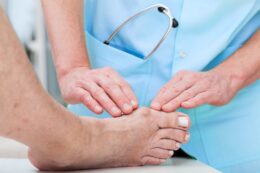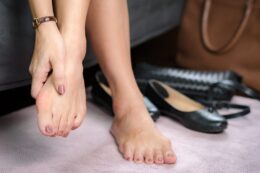Tagged with #bunionpain …
5 Non-Surgical Bunion Treatments
Bunions are a common foot problem characterized by a bony bump on the joint outside of the big toe. This condition can cause significant discomfort and pain and affect foot function and stability, so prompt treatment is essential. There are several non-invasive bunion pain relief options available. Here are some of them:
• Medications
This is one of the simplest and most common treatments to reduce bunion pain and inflammation. While some non-steroidal anti-inflammatory drugs (NSAIDs) can be bought over the counter, it’s best to get a professional’s advice first to ensure they’re safe and suitable to your needs. Sometimes, pain relief topical creams may also be recommended.
• Physical Therapy
A skilled physical therapist can create a personalized treatment program to help you manage bunion pain. Besides manual care, they may also recommend exercises that enhance joint mobility, strengthen the muscles surrounding the affected area, and improve overall foot function.
• Footwear Modifications
Wearing proper footwear can significantly improve bunion symptoms. When choosing shoes, make sure they’re well-fitting, comfortable, and have the proper support based on your needs. You should also opt for footwear with a wide toe box to ease pressure on your bunions and prevent further irritation. If you are unsure of your shoe size or choice, consult a podiatrist.
• Orthotic Inserts
Another effective non-surgical bunion treatment is custom orthotics. These are designed to add arch support and redistribute pressure across the foot, relieving pain and preventing your condition from worsening. Orthotic inserts can be worn in various types of shoes, so you can manage bunion pain even when going about your daily activities.
• Bunion Splints
This orthotic device helps realign your big toe joint, reducing symptoms like pain and discomfort. Bunion splints are usually worn overnight or during periods of rest. With regular use, they can slow down the progression of your foot condition.
Contact Thomas Podiatry & Associates Today
Learning about non-surgical treatments for bunions is helpful in case you or a family member develops this foot condition. Get in touch with Thomas Podiatry & Associates for reliable podiatric services in Salisbury, MD. Our trusted podiatrists can help you with bunion pain relief and more!
5 Tips To Prevent Bunion Pain
Bunions occur when excessive and continuous pressure on your feet forces your big toe to point toward the rest of your foot, causing misalignment. They are characterized by a bony bump that develops outside your big toe.
Aside from the pain and soreness, having bunions may also result in corns and calluses, further affecting your daily routines. That said, it’s best to learn how to prevent and alleviate bunion pain. Here’s what you should do:
- Wear Well-Fitting Shoes
One of the major risk factors for developing bunions is wearing tight, narrow, and pointy shoes. Because of the limited space ill-fitting footwear provides, they put excess pressure on your toes and mess with their proper alignment. If you already have a bunion, wearing these shoes will not only cause pain but also worsen your condition.
Because of this, it’s crucial to get footwear with the correct size. If possible, get a pair that has a roomy toe box, good arch support, and a comfortable fit.
- Use Padding or Shoe Inserts
Another way to prevent and reduce pain from bunions is by padding or adding orthotics to your shoes. Bunion pads provide additional cushioning to prevent your affected toe from rubbing against your shoes and causing discomfort. Meanwhile, custom shoe inserts help distribute pressure evenly on your feet, minimizing pain and the progression of your foot condition. To determine which works best for you, consult a podiatrist.
- Do Bunion Exercises
Exercising regularly helps improve your feet’s strength and mobility, thus relieving and preventing bunion symptoms like soreness and pain. Some exercises you can try are toe curls, toe stretches, towel crunches, and ball rolls. You can also talk to your foot doctor to ensure your routine is safe for your condition.
- Apply Ice to the Affected Area
This is one of the easiest ways to relieve painful, swollen bunions. If you notice these symptoms, especially after standing or walking all day, apply an ice pack on your feet for at least 10 minutes or more.
- Take Pain Medications
Of course, you can always take medication when you experience pain and inflammation with your bunions. A nonsteroidal anti-inflammatory medicine like ibuprofen can work wonders to reduce these symptoms. If necessary, your foot doctor may also prescribe a corticosteroid injection.
Contact Us at Thomas Podiatry & Associates
Learning about these tips will help ease any pain and discomfort associated with bunions. If you need a routine foot check-up or professional advice on your bunion pain, consult a podiatrist. Reach out to us at Thomas Podiatry & Associates in Salisbury, MD for reliable podiatric services.







